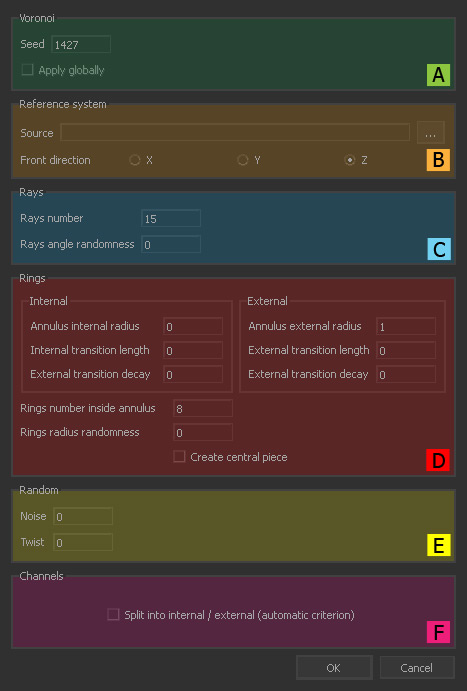With this tool it is possible to create radial patterns, suited to the creation of breaking glass or stucco. For a description of the used terms and a quick start please go to "Caronte - Voroni Radial: Quick Start".
Voronoi (A)
Seed
If you want to achieve a different distribution of fragments change this value – you can enter any positive integer.
Apply globally
This option only works with a → MultiBody. When enabled RealFlow treats the MultiBody's individual objects as one object and you will see a propagating pattern.
Reference System (B)
Source
The object specified here, e.g. a null, determines the radial pattern's centre and → orientation – the latter one is changed with the “Front direction” options.
Front direction
Here you specify the → orientation of the radial pattern based on the rotation of the node from “Source”. This way it is possible to rotate the web pattern on the surface of the fragmented object.
Rays (C)
Rays number
Here you can determine how many → rays you want to create.
Ray angle randomness
By default, all rays are created with the same angle between them. If you want to displace the rays enter a number between 0.0 and 1.0 (highest randomness).
Rings (D)
Annulus internal radius
This is the inner distance of the → annulus from the radial pattern's centre – the centre is specified through the object under “Source”. The unit is metres.
Internal transition length
Here you determine how far from the “Annulus internal radius” additional rings are created. The unit is metres.
Internal transition decay
Here you determine how fast the rings outside the annulus (measured from the inner boundary of the annulus) are separated. The value ranges between 0 (no decay) and 1 (maximum decay).
Annulus external radius
This is the outer distance of the annulus from the radial pattern's centre – the centre is specified through the object under “Source”.
External transition length
Here you determine how far from the “Annulus external radius” additional rings are created. The unit is metres.
External transition decay
Here you determine how fast the rings outside the annulus (measured from the outer boundary of the annulus) are separated. The value ranges between 0 (no decay) and 1 (maximum decay).
Rings number inside annulus
Enter, how many rings you want to create inside the annulus – the area between “Annulus internal radius” and Annulus external radius”.
Rings radius randomness
By default, all rings inside the annulus have exactly the same distance from each other; in transition zones, the rings obey the decay parameters – with a value of 0 (= no decay), the rings will be equispaced as well. To avoid this, enter a degree of randomness between 0.0 and 1.0 (maximum randomness).
Create central piece
When enabled a fragment is created directly at the centre of the radial pattern.
Random (E)
Noise
Add a small amount of random displacement to create a more random look. Values range between 0.0 and 1.0 (maximum noise).
Twist
You can also displace the radial pattern to get a look similar to a spiral or the arrangement of sunflower seeds. Valid values are between -1.0 (maximum twist counterclockwise) and 1.0 (maximum twist clockwise). With 0, no twist will be applied.
Channels (F)
Split into internal/external (automatic criterion)
With this option it is possible to store the fragments of the zones with higher and lower concentration in two individual → MultiBody nodes.
